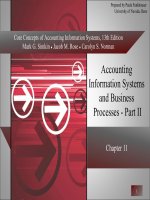Introductory visualizing technology 5th by debra geoghan chapter 11
Bạn đang xem bản rút gọn của tài liệu. Xem và tải ngay bản đầy đủ của tài liệu tại đây (1.29 MB, 33 trang )
PowerPoint Presentation to Accompany
Chapter 11
Databases
Objectives
1. Identify the Parts of a Database
2. Compare the Four Types of Databases
3. Explain Database Management Systems
4. Discuss Important Types of Information Systems
5. List Examples of Databases Used in Law
Enforcement and Research
Copyright © 2017 Pearson Education, Inc.
2
Identify the Parts of a Database
Objective 1
Copyright © 2017 Pearson Education, Inc.
3
Database Basics
Tables, Fields, and Records
Database
Collection of information
Organized in a useful way
Database records are
organized into tables
Objective 1
Copyright © 2017 Pearson Education, Inc.
4
Database Basics
Tables, Fields, and Records
Table
Database object
Data arranged in rows and columns
Field
Single piece of information in a record
Primary key a special field that uniquely identifies a record
Record
Row of data
Describes a particular entry
Objective 1
Copyright © 2017 Pearson Education, Inc.
5
Database Basics
Forms, Queries, and Reports
Form
Enter data and display information
Easy-to-read layout
Query
Retrieves specific data from one
or more tables
Report
Displays the data from a table or a query
Easy-to-read-and-print format
Objective 1
Copyright © 2017 Pearson Education, Inc.
6
Compare the Four Types of Databases
Objective 2
Copyright © 2017 Pearson Education, Inc.
7
A Database for Every Purpose
Flat Databases
Simplest type
Consists of a single list of items
Can be a list or a table in a
document or spreadsheet
Examples:
Shopping list
To-do list
Objective 2
Copyright © 2017 Pearson Education, Inc.
8
A Database for Every Purpose
Relational Databases
Most common type
Multiple tables or relations
Related by common information
Reduces data redundancy
Objective 2
Copyright © 2017 Pearson Education, Inc.
9
A Database for Every Purpose
Relational Databases
Types of relationships:
One-to-many – a single record in one table links to multiple
records in another table
One-to-one – a single record in one table links to a single
record in another table
Many-to-many – Multiple records in one table can link to
multiple records in another table
Objective 2
Copyright © 2017 Pearson Education, Inc.
10
A Database for Every Purpose
Object-Oriented Databases
Data stored as objects
Used by modern programming
languages
C++
Java
Used for more complicated types
of data
Images
Video
Audio
Objective 2
Copyright © 2017 Pearson Education, Inc.
11
A Database for Every Purpose
Multidimensional Databases
Optimized for storing and utilizing data
Can be created using input from existing relational
databases
Structures information as multidimensional data cubes
Objective 2
Copyright © 2017 Pearson Education, Inc.
12
A Database for Every Purpose
Multidimensional Databases
Data warehouse
Central repository for all data that an enterprise uses
Data mining
Discovering relationships between data items
Online analytical processing (OLAP)
Enables users to selectively extract and view data from
different points of view
Objective 2
Copyright © 2017 Pearson Education, Inc.
13
Explain Database Management Systems
Objective 3
Copyright © 2017 Pearson Education, Inc.
14
The Tools of the Trade
Creating a Database
A database management system (DMS) is software
used to create and manage data in a database
Examples:
Microsoft Access
MySQL
Microsoft SQL Server
Oracle
FileMaker Pro
Objective 3
Copyright © 2017 Pearson Education, Inc.
15
The Tools of the Trade
Creating a Database
Data dictionary
Defines data fields and types of data
Data type
Defines the kind of data to enter into a field
Data normalization
Reduces data redundancy
Reduces the size of the database
Easier to keep records up to date
Increases query speed
Objective 3
Copyright © 2017 Pearson Education, Inc.
16
The Tools of the Trade
Data Validation
Reduces data entry errors
Prevents user from entering
wrong type of information
Objective 3
Copyright © 2017 Pearson Education, Inc.
17
The Tools of the Trade
Structured Query Language (SQL)
A query language is used to ask questions in a
database
Structured Query Language(SQL) is the query
language used in most DBMSs today
SQL statements use relational keywords:
SELECT
WHERE
FROM
AND
Objective 3
Copyright © 2017 Pearson Education, Inc.
18
The Tools of the Trade
Output
Objective 3
Copyright © 2017 Pearson Education, Inc.
19
Discuss Important Types
of Information Systems
Objective 4
Copyright © 2017 Pearson Education, Inc.
20
Data In … Information Out
Office Support Systems (OSS)
Also called office automation systems
Software and hardware that improves productivity of
employees
Automates common tasks
Microsoft Office
Objective 4
Copyright © 2017 Pearson Education, Inc.
21
Data In … Information Out
Transaction Processing (TPS)
Links multiple operations that make
up a transaction
Ensures all operations in transaction
are completed without error
Must pass the ACID test
Atomicity
Consistency
Isolation
Durability
Example: paying tuition bill
Objective 4
Copyright © 2017 Pearson Education, Inc.
22
Data In … Information Out
Management Information Systems
(MIS)
Includes:
Software
Hardware
Data resources
Decision support systems
People
Project management applications
Generates reports
Creates “What-if” simulations
Example: HR manager could use an MIS for hiring and
recruiting
Objective 4
Copyright © 2017 Pearson Education, Inc.
23
Data In … Information Out
Decision Support Systems (DSS)
Helps make decisions
when there is
uncertainty about
outcomes
Example: local business
wanting to expand
Objective 4
Copyright © 2017 Pearson Education, Inc.
24
Data In … Information Out
Business Intelligence (BI) and Big Data
People, hardware, and software that support dataintensive applications
Data mining
Data warehousing
OLAP
DSSs
Big data
Simply means the collection of large amounts of data from
multiple sources
Objective 4
Copyright © 2017 Pearson Education, Inc.
25









